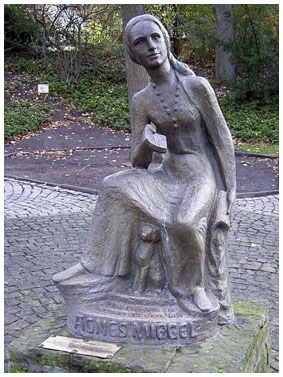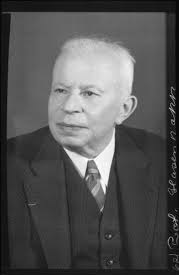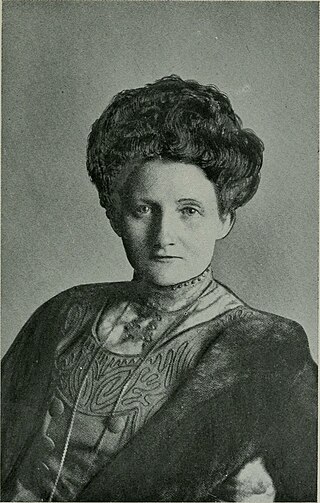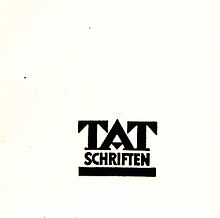
Eugen Rosenstock-Huessy was a historian and social philosopher, whose work spanned the disciplines of history, theology, sociology, linguistics and beyond. Born in Berlin, Germany into a non-observant Jewish family, the son of a prosperous banker, he converted to Christianity in his late teens, and thereafter the interpretation and reinterpretation of Christianity was a consistent theme in his writings. He met and married Margrit Hüssy in 1914. In 1925, the couple legally combined their names. They had a son, Hans, in 1921.

Wilhelm Johann Eugen Blaschke was an Austrian mathematician working in the fields of differential and integral geometry.

Ernst Klee was a German journalist and author. As a writer on Germany's history, he was best known for his exposure and documentation of medical crimes in Nazi Germany, much of which was concerned with the Action T4 or involuntary euthanasia program. He is the author of "The Good Old Days": The Holocaust Through the Eyes of the Perpetrators and Bystanders first published in the English translation in 1991.
Wolfgang Justin Mommsen was a German historian. He was the twin brother of historian Hans Mommsen and the great-grandson of Theodor Mommsen.

Agnes Miegel was a German author, journalist and poet. She is best known for her poems and short stories about East Prussia, but also for the support she gave to the Nazi Party.
Ferdinand Friedrich Zimmermann was a German author and journalist. He used his pseudonym of Ferdinand Fried to publish.

Eugen Diederichs was a German publisher born in Löbitz, in the Prussian Province of Saxony.

The Deutsche Freischar – Bund der Wandervögel und Pfadfinder (DF) is a German youth organization. Originating from the merger of several small Wandervogel and Scouting groups, it was one of the largest and most important associations of the Bündische Jugend of the Weimar Republic besides the Deutscher Pfadfinderbund and Reichsschaft Deutscher Pfadfinder.
Walter Friedrich Gustav Hermann Otto was a German classical philologist particularly known for his work on the meaning and legacy of Greek religion and mythology, especially as represented in his seminal 1929 work The Homeric Gods.
Ilse Schwidetzky was a German anthropologist.

Otto Max Helmuth von Glasenapp was a German indologist and religious scholar who taught as a professor at the University of Konigsberg in East Prussia (1928–1944) and Tübingen (1946–1959).
The Freethinkers Association of Switzerland (FAS) is a Swiss nonprofit organisation for freethought. It is the result of the merger of several late 19th century and early 20th century local freethinkers associations throughout Switzerland into a national society, currently headquartered in Bern.
Diederichs is a German book publisher based in Munich, Bavaria. Founded in 1896 by Eugen Diederichs, it profoundly shaped intellectual life at the beginning of the 20th century. After three generations as a family-owned enterprise, from 1988 the firm was owned by Hugendubel. Since 2008, it has been part of the Verlagsgruppe Random House.
Giselher Schubert is a German musicologist.
Giselher Wirsing was a right-wing German journalist, author, and foreign policy expert who was active during Nazi Germany and the Bonn republic. He was a member of the Nazi party and contributed heavily to the creation and propagation of Nazi propaganda outside Germany.
Notker Hammerstein was a German historian. His research interests were mainly in the field of University history and history of science as well as the history of the Holy Roman Empire of the German Nation.
Rudolf Fritz Karl Berthold Bode was a German educator and founder of expressive gymnastics His central concerns were holistic movement, its rhythmic design and the interaction of body and soul. He was an active supporter and propagandist for National Socialism from the early 1930s.

Eugen Fehrle was a German philologist who specialized in classical and Germanic philology.
Hugo Haberfeld, was an Austrian Jewish art dealer, who owned the Miethke Gallery in early 20th century Vienna. When Austria joined Nazi Germany in the 1938 Anschluss, Haberfeld fled to Paris.

Lulu von Strauss und Torney (1873–1956) was a German poet and writer. Best remembered for her ballads, she also wrote historical fiction with rural settings in northwest Germany.









